UTS Honorary Adjunct Research Fellow Dr Anya Salih has been monitoring coral around Heron Island for 30 years. She says the devastation from the latest bleaching event is overwhelming.
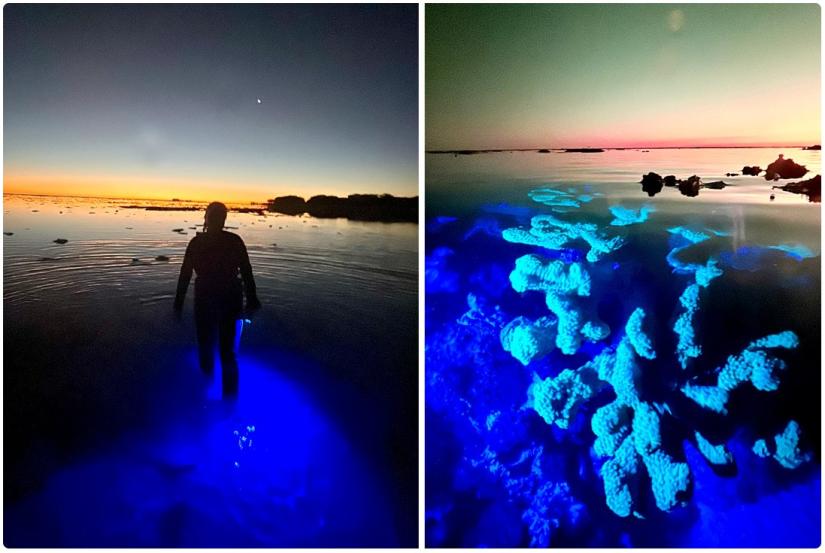
(L) Dr Anya Salih with blue torch on the reef at dusk searching for fluorescent corals. (R) Resilient to bleaching and very fluorescent Isopora palifera in Heron Island lagoon. Image: Anya Salih
In the wake of the worst coral bleaching event ever recorded in the southern Great Barrier Reef, I travelled to Heron Island to continue research I started over 30 years ago. This time, the devastation was overwhelming.
The once vibrant and highly diversified reef had transformed into a desolate wasteland. Yet, amidst the destruction one striking element shone though — a vividly coloured phenomenon called coral fluorescence. And we believe it can help us predict which corals will survive in the short-term on the reef.
Coral fluorescence is where corals emit a bright light under UV or blue illumination, and it has fascinated me for years. The function of this glowing display, mostly green but often blue, orange, or red, is not fully understood.
My research and that of other scientists, found it plays a crucial role in corals’ resilience to the threats like warming water caused by climate change. These fluorescent pigments regulate light within the coral, shielding them from excessive sunlight, amplifying it when light is limited and aiding photosynthesis — the process of transforming light into energy.
Before:
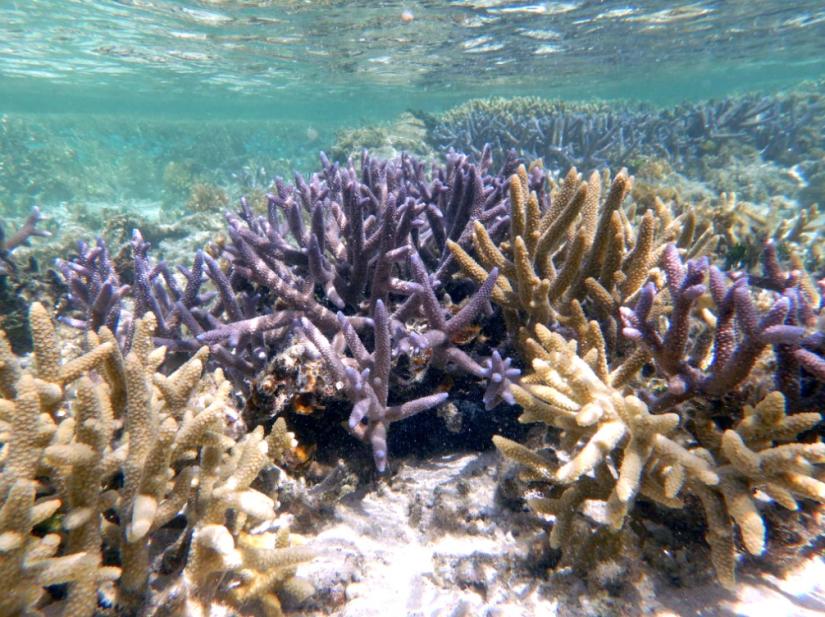
Reef lagoon where large areas of fast growing Acropora thickets thrived. 2019 (Before 2024 mass bleaching mortalities). Rob Brennan
After:
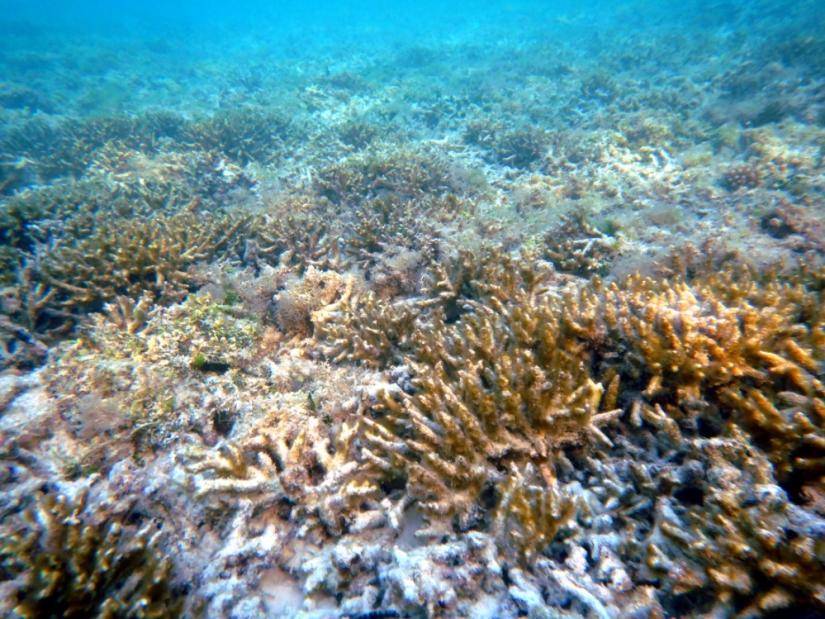
Reef lagoon where large areas of fast growing Acropora thickets thrived. After 2024 mass bleaching mortalities. Rob Brennan.
Under water in the 'eerily apocalyptic' reef
The beauty and significance of coral fluorescence stands in stark contrast to the current state of the Heron Island reefs. The once-thriving ecosystem has been decimated by climate change, with dead corals now overgrown by algae.
Recent aerial surveys by the Great Barrier Reef Marine Park Authority revealed ocean temperatures started increasing late last year, leading to the confirmation of the fifth mass bleaching event on the Great Barrier Reef by March 2024. This event was the most extensive ever recorded, with almost half the reefs experiencing record levels of heat stress.
Accompanied by Rob Brennan, a Californian artist and businessman, who had regularly assisted me in researching the reef, we witnessed an unprecedented degree of coral mortalities following this latest bleaching. Corals were not just bleached, most were dead. We were at ground zero, finding that most corals on the upper reef slopes were dead, already overgrown with dark brown algae that made the scene eerily apocalyptic.
In the lagoon and the reef crest, large areas were also dead. Roberta Dixon-Valk, marine ecologist and co-founder of conservation non-profit Take 3 for the Sea, who assisted our research was also appalled by what she saw. “Having been fortunate to visit Heron Island as a student in 1984 and then again with Dr Anya Salih 20 years ago, it breaks my heart that I am a witness to this reef’s destruction," she said.
What fluorescence can tell us about coral survival
Swimming with my blue-light torch at dusk, I discovered that there was a shift in the surviving corals’ composition and assisted by Rob Brennan and Roberta Dixon-Valk, I found an unusual change.
Most of the corals that were strongly fluorescent were the clear winners in the struggle to survive.
To view fluorescence, we used blue-light torches to illuminate corals in the dark at dusk because, in daylight, the strong sunlight overwhelms fluorescence. But in the dark fluorescence can be so bright that it blinds the eyes.
However, the overall diversity of coral colours had drastically reduced, with non-fluorescent varieties almost entirely wiped out. The once abundant branching Acropora had suffered devastating losses, with only small patches of fluorescent colonies remaining.
The strikingly beautiful large table-like acropora corals suffered devastating losses, with less than one per cent of the once-thriving community now surviving. It was incredibly heartbreaking to see the reef I grew to love and know so well, to be decimated. I never imagined that this would happen in my lifetime.
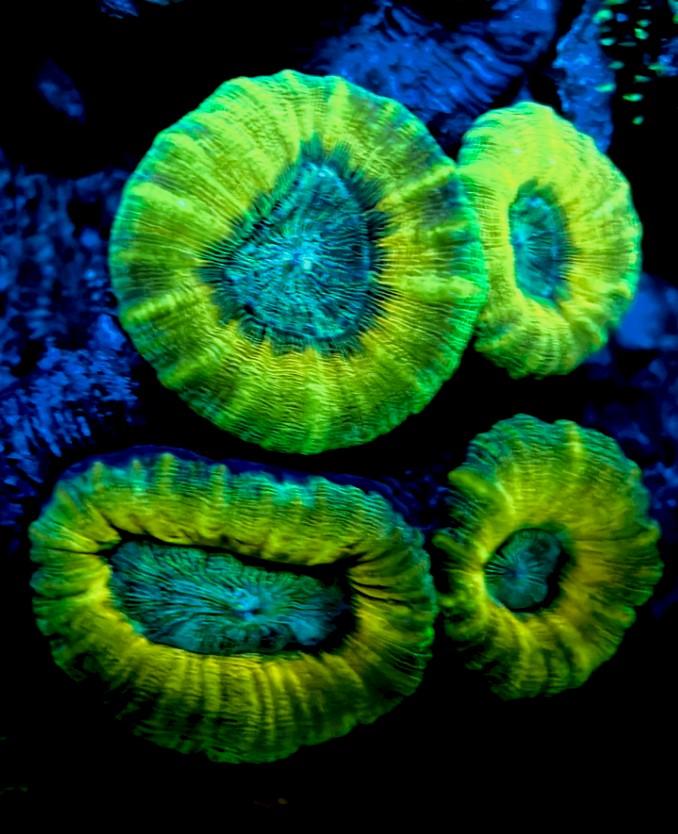
Fluorescent Lobophyllia sp – a coral from Heron lagoon. Photo by Anya Salih.
Even fluorescent corals failing as waters warm
During our visit, I was joined by a group of scientists from the University of Copenhagen, Denmark, led by Professor Michael Kuhl. The team worked with me to study coral fluorescence and how these pigments protect corals from excessive sunlight, which exacerbates the impact of increased water temperatures.
The Danish team brought highly sophisticated equipment including microsensors and 3D mapping technology to measure corals' responses to light and temperature. We were able to compare corals with and without their colourful fluorescent pigments to understand their effect on coral resilience. However, as temperatures continue to climb, even these defences become overwhelmed, and large areas of previously resilient fluorescent corals were found dead.

Heron Island reef slope after the bleaching event. Photo: Rob Brennan
Why increased coral cover on the reef is not good news
The initial surveys for the 2023-2024 global mass coral bleaching event by the Great Barrier Reef Marine Park Authority and Australian Institute of Marine Science (AIMS) were very grim, particularly for the southern Great Barrier Reef, where Heron Island is located.
But how is it that annual surveys prior to 2024 by AIMS scientists reported coral cover on the Great Barrier Reef has remained stable, even after severe crashes after the consecutive bleaching events in 2016, 2017 and 2019?
The fact that the coral cover recovered after the back-to-back bleaching events from 2016 to 2022 has been used by some conspiracy theorists to argue climate change and its damaging effects on reefs have been exaggerated by scientists.
The reason for the recorded high cover on recovering reefs is similar to what happens in an old-growth forest with diverse communities of slow and fast-growing trees. When this diverse community is destroyed, it is replaced by fast-growing, low-diversity forests that have a low ability to withstand stresses and crash easily. On the Great Barrier Reef, the lowered diversity but high cover achieved by branching, fast growing corals makes these reefs vulnerable to further temperature increases. They crash and die quickly.
I believe that the recovery of reefs devastated by rising seawater temperatures is becoming increasingly difficult and, in some places, impossible. As temperatures continue to climb due to climate change, back-to-back bleaching events are wearing down corals' ability to recover, leading to their collapse. There is almost no scope for adaptation at such rapidly increasing temperature rates. Reproduction will be increasingly affected, and there will be no new recruitment of young corals to repopulate.
Before:
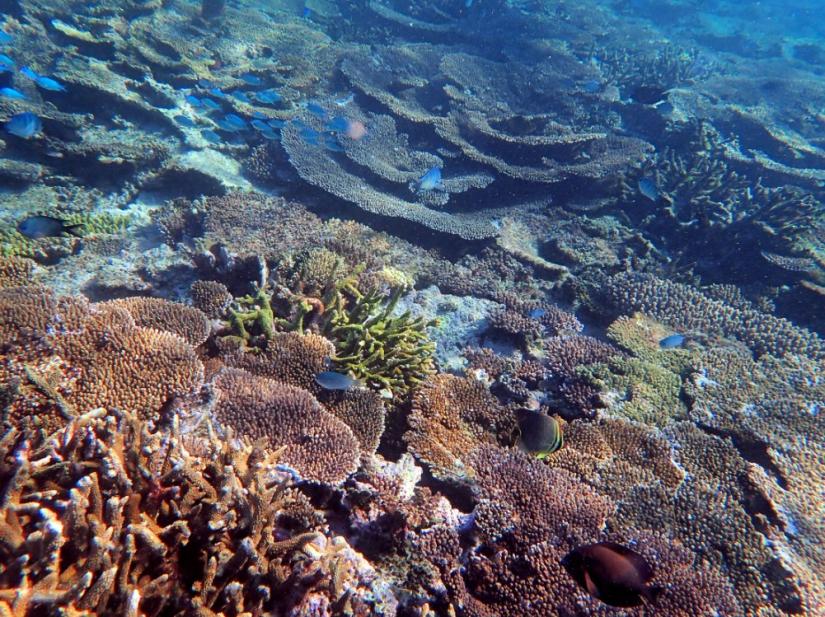
Reef upper slope with many branching and tabular Acropora corals. Before the 2024 mass bleaching mortalities. Photo: Anya Salih.
After:
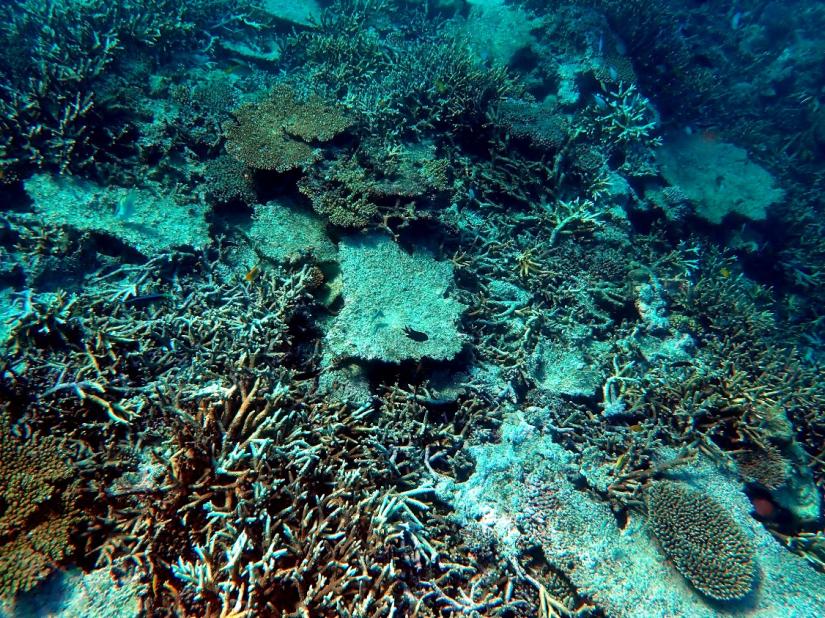
Reef upper slope with many branching and tabular Acropora corals. After the 2024 mass bleaching mortalities. Photo: Anya Salih.
Reef's collapse a 'dire warning' for planet
Rob Brennan said he felt "traumatised" by what he witnessed. “What we saw was completely devastating — dead and dying corals, collapsed reef tops, bleached and dying corals everywhere. No one forecast such a rapid collapse. These reefs are now extremely stressed, and with sea temperatures continuing to rise, corals can't adapt fast enough. I am grateful that I've had the opportunity to have spent so many hours on these reefs assisting with research, and experienced the magic and mystery of corals, and a vibrant coral reef. We are in an extinction event, and I am a witness to it. I am now concerned for the viability of the planet as we knew it 10 years ago!”
The coral catastrophe unfolding at Heron Island serves as a dire warning, highlighting the irreversible damage wrought by human-induced environmental changes. The increasing temperatures driven by climate change sicken corals. They bleach and lose their life-supporting micro-algae, reducing corals' ability to recover between bleaching events, which have become so frequent that they are occurring almost every year. Even the most resilient corals, so-called super corals, can’t keep up with the building stresses and succumb.
What can individuals do to help save the reef? Immediate and decisive measures are necessary to slow global warming and give corals a chance to adapt and survive. As individuals, we can contribute to the fight against climate change by reducing our carbon footprint, supporting sustainable practices, and advocating for strong environmental policies. The future of the Great Barrier Reef and countless other ecosystems depends on our collective actions.
This article was first published in Yahoo News.
Dr Anya Salih is an Honorary Adjunct Senior Research Fellow at the School of Life Sciences, University Technology Sydney. She has extensively researched the impacts of climate change on coral reefs and pioneered studies on coral fluorescence. Her work includes discovering novel coral fluorescent proteins for bioimaging applications, enhancing the study of healthy and diseased cells using fluorescence and confocal microscopy. In addition to collaborating with scientists across disciplines, she works closely with filmmakers and artists to explore and communicate the beauty and complexity of coral fluorescence. She is passionate about conservation and climate change.

